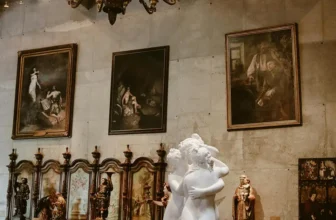What is The Monk by the Sea All About
Shopping Ads: Antique Oil Paintings On Canvas For Sale. Limited Originals Available 💰😊
Authentic hidden masterpieces, Explore old master antique oil paintings from the Renaissance and Baroque eras. From 15th-century to 18th-century Antique Paintings. Bring the Renaissance and Baroque in your home. Shop Now!
🎨 Antique Oil Paintings On Canvas Renaissance, Baroque Art Antique Oil Paintings, Make Offer 16th to 18th Century Portrait Paintings
In the muted absence of a stark seascape, a solitary figure gazes into the boundless void of the horizon. He is neither dramatic nor detailed, just a black silhouette standing against an overwhelming backdrop of sea and sky. This is “The Monk by the Sea” (German: Der Mönch am Meer), one of the most haunting and contemplative masterpieces of Caspar David Friedrich, the 19th-century German Romantic painter known for his meditative and spiritual landscapes.
Painted between 1808 and 1810, The Monk by the Sea remains one of Friedrich’s most enigmatic and minimalist compositions. Though simple in form, the painting contains within it a universe of ideas, about solitude, the sublime, spirituality, and man’s place in the vastness of nature. Today, this canvas continues to captivate viewers at the Alte Nationalgalerie (Old National Gallery) in Berlin, where it resides, still resonating with a timeless whisper that speaks to the soul.
At its surface, The Monk by the Sea depicts a lone monk standing on a narrow strip of sand or dunes, facing the immense and unfathomable sea, beneath an overcast sky. There are no trees, no birds, no boats, nothing but sea, sky, and the tiny human presence. The composition is divided into three almost monochromatic horizontal bands: the earth below, the vast sea in the middle, and the equally expansive sky above. The transition between these bands is almost imperceptible, suggesting that land, water, and air are bleeding into one another in a quiet communion of elements.
But what is really happening here? While there’s no narrative action in the conventional sense, something deeply psychological and existential is unfolding. The monk is not doing anything, he’s simply standing still, confronting the immensity before him. This moment of quiet reflection, of man facing the infinite, becomes the emotional and philosophical centerpiece of the artwork.
It is not a scene to be understood in terms of events or storylines. Rather, it is a meditative space, where the viewer joins the monk in confronting the eternal, the unknowable, and perhaps even the divine.
What Does The Monk by the Sea Painting Mean?
Friedrich’s work has often been seen through the lens of Romanticism, a movement that emphasized emotion, individualism, and a profound reverence for nature. But Friedrich took Romanticism a step further by infusing it with a deep spirituality and a Protestant sense of inner reflection.
1. The Monk as a Symbol of Humanity
The figure of the monk is not meant to be read literally. He is not a specific person, but rather a stand-in for every human being, caught in the act of contemplation. His monastic garb suggests a life devoted to spiritual practice, solitude, and renunciation of worldly distractions. In that sense, the monk becomes a symbol of inner seeking, a soul striving to comprehend the mysteries that lie beyond the visible world.
His small, dark figure, dwarfed by the surrounding void, emphasizes the theme of human insignificance in the face of the infinite. The way he stands, utterly still and facing the horizon, evokes both humility and yearning.
2. The Sea as the Sublime
The sea has long been a metaphor in Western art and literature, often representing the unknown, the unconscious, or the divine. In The Monk by the Sea, the sea takes on an almost metaphysical quality. It is vast, calm, and yet unnerving. Its indistinct edges and lack of detail suggest that it could go on forever, or that it is a boundary between this world and another.
Friedrich’s use of the sea aligns closely with the concept of the sublime, a key idea in Romantic thought. The sublime refers to experiences that are simultaneously beautiful and terrifying, feelings that arise when one is confronted with something vastly greater than oneself. The monk, standing before the sea, is caught in that sublime moment, and so are we.
3. The Sky and the Spiritual Realm
The sky in this painting is overcast and gray, occupying the largest portion of the canvas. It is not luminous or heavenly in the conventional sense. Instead, it is a blank expanse, perhaps a metaphor for the unknowable. There are no angels, no celestial signs, no divine figures, just an empty, cloudy sky. This absence is key: it suggests a spiritual silence, a space in which faith must exist without certainty, and where the divine is present in absence.
In this way, Friedrich was expressing a Lutheran mysticism, a belief that God is not found in ornate cathedrals or dramatic visions, but in quiet contemplation, solitude, and the profound experience of nature.
What Type of Art is The Monk by the Sea Painting?
The Monk by the Sea is a quintessential example of German Romantic landscape painting, but with a highly unique and pioneering aesthetic. Friedrich broke away from the picturesque landscapes of his time by removing nearly all narrative or decorative elements, pushing the boundaries of what a landscape could express.
Minimalism Before Its Time
One of the most revolutionary aspects of the painting is its radical minimalism. In an age when landscape painting often featured pastoral scenes, detailed flora, animals, and mythological figures, Friedrich chose to depict emptiness. The horizon line is nearly flattened; the palette is restrained; and the vastness of the canvas overwhelms the viewer. This was avant-garde for its time and anticipated modern movements such as abstract expressionism and minimalist art.
Theological Romanticism
While firmly rooted in Romantic ideals, Friedrich’s art also served a theological function. He believed that art should not only depict the world, but also elevate the soul. In that sense, The Monk by the Sea becomes a visual sermon, not didactic or dogmatic, but contemplative and emotional, inviting the viewer into a sacred moment of awareness.
What Is Happening in the Painting?
At first glance, it seems that nothing is happening. And that’s precisely the point. The lack of action allows the viewer to pause and enter into a meditative state. The painting does not tell a story in the traditional sense; instead, it creates an atmosphere, a psychological and spiritual environment.
Here, “happening” occurs not on the canvas, but within the viewer. The stillness of the monk and the surrounding void provoke inner movement, questions about life, death, meaning, and the afterlife. What happens is not in the brushstrokes but in the heart: a confrontation with our own solitude, mortality, and longing.
Some art historians suggest that Friedrich may have meant to evoke mourning or resignation, perhaps reflecting his personal losses and melancholic disposition. Others view it as an image of transcendence, a symbolic death of the ego and a union with the eternal.
The Painting’s Reception and Historical Context
When The Monk by the Sea was first exhibited in 1810, it caused considerable confusion and debate. Many critics were unsettled by its lack of detail and conventional beauty. Some considered it too bleak, too empty, even unfinished.
Yet others, especially the poet Heinrich von Kleist, recognized its emotional and philosophical depth. In his review, Kleist described the painting as if “one’s eyelids had been cut away”, a vivid way of expressing how the painting forces the viewer into raw confrontation with reality.
This reaction captures what makes Friedrich so enduring: his ability to bypass decorative appeal and speak directly to the spiritual core of human experience.
Where is The Monk by the Sea Painting Today?
Today, The Monk by the Sea can be seen at the Alte Nationalgalerie (Old National Gallery) in Berlin, Germany, where it continues to be one of the most iconic and studied works in the collection.
It is often displayed alongside its companion piece, “The Abbey in the Oakwood” (Abtei im Eichwald), which depicts a ruined Gothic abbey surrounded by monks and barren trees. Together, the two works were originally conceived as a diptych, offering a meditative journey from the sea’s emptiness to the solemn finality of the grave.
Friedrich’s painting has had a profound influence on modern and contemporary art, philosophy, and even cinema. Artists like Mark Rothko, Gerhard Richter, and Anselm Kiefer have drawn inspiration from his atmospheric restraint and spiritual depth. Filmmakers such as Andrei Tarkovsky and Terrence Malick have echoed his contemplative visual language in their cinematic landscapes.
The Monk by the Sea has also found resonance in existential philosophy, particularly in the writings of Martin Heidegger, who explored the concept of “being-toward-death” and the need to confront the void to fully experience authentic existence.
A Silent Mirror of the Soul
Caspar David Friedrich’s The Monk by the Sea is not a painting that shouts. It whispers. And in its whisper, it speaks volumes. It invites us to stand, like the monk, on the edge of understanding, and look out, not to find answers, but to dwell in the mystery.
The power of the painting lies not in what it depicts, but in what it evokes. In a world often saturated with noise, The Monk by the Sea offers the radical stillness of inner silence. It challenges us to ask: What happens when we remove the clutter of the world? What remains when we strip life down to its elemental forces, earth, sea, sky?
What remains is what has always been there: the self, alone, looking for meaning in the face of the infinite.




